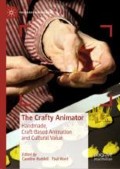Abstract
This chapter explores three examples of digital animation which conspicuously emulate handcrafted, cutout, home-made techniques, interrogating the various functions these imperfect aesthetics serve. Charlie and Lola’s montage style aligns the show with traditional culture aimed at and made by children, Comedy Central’s South Park evokes the amateur style of countercultural underground animation, while The Lego Movie’s stop-frame look connects with fan culture and adult toy animation. Variously producing a sense of naivety, unprofessionalism, playfulness and subversion, these aesthetic choices serve to negotiate tensions and contradictions circulating animation’s commercial, industrial and cultural status. In particular, the implication of a mythical child figure in these franchises’ production processes mediates their complex status as screen media, their relationship to modernity and technology and their appeal to audiences of adults and children.
Access this chapter
Tax calculation will be finalised at checkout
Purchases are for personal use only
References
Aldred, Jessica. 2014. “(Un)Blocking the Transmedia Character: Digital Abstraction as Franchise Strategy in Traveller’s Tales’ Lego Games.” In Lego Studies: Examining the Building Blocks of a Transmedial Phenomenon, edited by Mark J.P. Wolf, 105–117. London: Routledge.
Bashara, Dan. 2015. “Cartoon Visions: UPA, Precisionism and American Modernism.” Animation: An Interdisciplinary Journal 10 (2): 82–101.
Buckingham, David. 1997. “On the Impossibility of Children’s Television: The Case of Timmy Mallett.” In In Front of the Children: Screen Entertainment and Young Audiences, edited by Cary Bazalgette and David Buckingham, 47–61. London: BFI.
Buerkle, Robert. 2014. “Playset Nostalgia: Lego Star Wars: The Video Game and the Transgenerational Appeal of the Lego Video Game Franchise.” In Lego Studies: Examining the Building Blocks of a Transmedial Phenomenon, edited by Mark J.P. Wolf, 118–152. London: Routledge.
Edwards, Susan. 2010. “Numberjacks Are on Their Way! A Cultural Historical Reflection on Contemporary Society and the Early Childhood Curriculum.” Pedagogy, Culture and Society 18 (3): 261–272.
Gardiner, Judith Kegan. 2000. “South Park, Blue Men, Anality, and Market Masculinity.” Men and Masculinities 2 (3): 251–271.
Gardiner, Judith Kegan. 2005. “Why Saddam Is Gay: Masculinity Politics in South Park—Bigger, Longer, and Uncut.” Quarterly Review of Film and Video 22: 51–62.
Geraghty, Lincoln. 2014. Cult Collectors: Nostalgia, Fandom and Collecting Popular Culture. London: Routledge.
Gournelos, Ted. 2009. “Blasphemous Allusion: Coming of Age in South Park.” Journal of Communication Inquiry 33 (2): 143–168.
Gray, Jonathan. 2006. Watching with the Simpsons: Television, Parody, and Intertextuality. London: Routledge.
Home, Anna. 1993. Into the Box of Delights: A History of Children’s Television. London: BBC Books.
Jenkins, Henry. 1993. “‘Going Bonkers!’: Children, Play and Pee-Wee.” In Male Trouble, edited by Constance Penley and Sharon Willis, 157–180. London: University of Minnesota Press.
Johnson, Derek. 2014. “Chicks with Bricks: Building Creativity Across Industrial Design Cultures and Gendered Construction Play.” In Lego Studies: Examining the Building Blocks of a Transmedial Phenomenon, edited by Mark J.P. Wolf, 81–104. London: Routledge.
Kirkland, Ewan. 2017. Children’s Media and Modernity: Film, Television, Digital Games. London: Peter Lang.
Langer, Mark. 1992. “The Disney-Fleischer Dilemma: Product Differentiation and Technological Innovation.” Screen 33 (4): 343–360.
Larsen, David. 2001. “South Park’s Solar Anus, or, Rabelais Returns: Cultures of Consumption and the Contemporary Aesthetic of Obscenity.” Theory, Culture and Society 18 (4): 65–82.
Leslie, Esther. 2004. Hollywood Flatlands: Animation, Critical Theory and the Avant-Garde. London: Verso.
Messenger Davies, Máire. 2001. ‘Dear BBC’: Children, Television Storytelling and the Public Sphere. Cambridge: Cambridge University Press.
Messenger Davies, Máire. 2005. “‘Crazyspace’: The Politics of Children’s Screen Drama.” Screen 46 (3): 389–399.
Mittell, Jason. 2003. “The Great Saturday Morning Exile: Scheduling Cartoons on Television’s Periphery in the 1960s.” In Prime Time Animation: Television Animation and American Culture, edited by Carol A. Stabile and Mark Harrison, 33–54. London: Routledge.
Moritz, William. 2009. “Some Critical Perspectives on Lotte Reiniger.” In Animation: Art and Industry, edited by Maureen Furniss, 13–19. New Barnet: John Libbey.
Moseley, Rachel. 2016. Hand-Made Television: Stop-Frame Animation for Children in Britain, 1961–1974. Basingstoke: Palgrave Macmillan.
Osmond, Andrew. 2017. “The Lego Batman Movie.” Sight & Sound 27 (4): 84.
Pilling, Jayne. 1997. “Introduction.” In A Reader in Animation Studies, edited by Jayne Pilling, ix–xviii. London: John Libbey.
Quigley, Marian. 2009. “Glocalisation vs. Globalization: The Work of Nick Park and Peter Lord.” In Animation: Art and Industry, edited by Maureen Furniss, 55–62. New Barnet: John Libbey.
Rose, Jacqueline. 1984. The Case of Peter Pan, or, The Impossibility of Children’s Fiction. London: Macmillan.
Schulzke, Marcus. 2012. “Contentious Language: South Park and the Transformation of Meaning.” Journal of Popular Film and Television 40 (1): 22–31.
Singer, Leigh. 2017. “The Year in… Animation.” Sight & Sound 27 (1): 46–47.
Sobchack, Vivian. 2009. “Animation and Automation, or, the Incredible Effortfulness of Being.” Screen 50 (4): 375–391.
Stables, Kate. 2014. “The Lego Movie.” Sight & Sound 24 (4): 77.
Steemers, Jeanette. 2010. “The BBC’s Role in the Changing Production Ecology of Preschool Television in Britain.” Television & New Media 11 (1): 37–61.
Varul, Matthias Zick. 2018. “The Cultural Tragedy of Production and the Expropriation of the Brickolariat: The Lego Movie as Consumer-Capitalist Myth.” European Journal of Cultural Studies 21 (6): 724–743.
Wagner, Keith B., and In-gyoo Jang. 2016. “The 3-D Animated Codescape: Imperfection and Digital Labor Zones in Wall-E (2008) and Wreck-It Ralph (2012).” Animation: An Interdisciplinary Journal 11 (2): 130–145.
Wells, Paul. 2002. Animation and America. Edinburgh: Edinburgh University Press.
Author information
Authors and Affiliations
Corresponding author
Editor information
Editors and Affiliations
Rights and permissions
Copyright information
© 2019 The Author(s)
About this chapter
Cite this chapter
Kirkland, E. (2019). Handmade Aesthetics in Animation for Adults and Children. In: Ruddell, C., Ward, P. (eds) The Crafty Animator. Palgrave Animation. Palgrave Macmillan, Cham. https://doi.org/10.1007/978-3-030-13943-8_6
Download citation
DOI: https://doi.org/10.1007/978-3-030-13943-8_6
Published:
Publisher Name: Palgrave Macmillan, Cham
Print ISBN: 978-3-030-13942-1
Online ISBN: 978-3-030-13943-8
eBook Packages: Literature, Cultural and Media StudiesLiterature, Cultural and Media Studies (R0)

